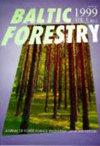Semi-mechanized planting of saplings: pivotal results on the efficiency of a new method
IF 0.7
4区 农林科学
Q3 FORESTRY
引用次数: 0
Abstract
Large clear-cut areas as a consequence of drought and bark beetle infestations necessitate extensive replanting efforts in German forests, leading to an increased interest in efficient planting systems. In addition to manual planting, mechanized and semi-mechanized systems utilizing surplus forest machine capacities available after completion of salvage logging operations are likely required for timely reforestation of the clear-cut areas. A semi-mechanized system utilizing a standard forwarder with a grapple-actuated soil borer for both, the transport of planting material and the preparation of planting pits, combined with two workers carrying out manual planting, was investigated in a time-and-motion study. The frequency method was used after video recording of a planting operation that covered an area of approximately 1.2 hectares. A total of 815 alder saplings (Alnus glutinosa L.) with heights of 1.2–1.5 m were planted. Observed productivity was 93 saplings per system work hour (SWH). With additional placement of stakes for stabilizing the plants, the productivity decreased to 42 saplings per SWH. While directly comparable results were not found in the literature, available productivity figures of purely manual planting systems do not suggest an increased productivity of this semi-mechanized system. Considering ergonomics, however, forwarder utilization provides reduced workload not only in plant hole preparation but also with material transport and clearing of planting spots. Both the ergonomic aspects of the system and, in particular, the suitability of the soil borer for different soil textures should be further investigated. Keywords: time studies; forwarder; stand regeneration; windthrow; forest operations半机械化种植树苗:新方法效率的关键成果
由于干旱和树皮甲虫的侵袭,德国森林中出现了大面积的砍伐区,这就需要在德国森林中广泛开展重新植树造林工作,从而使人们对高效的植树造林系统产生了更大的兴趣。除了人工植树外,还可能需要机械化和半机械化系统,利用抢救性采伐作业完成后剩余的林木机械能力,及时对砍伐区域进行植树造林。在一项时间和运动研究中,对一种半机械化系统进行了调查,该系统利用带有抓斗驱动土壤钻的标准转运车来运输种植材料和准备种植坑,并由两名工人进行人工种植。在对面积约为 1.2 公顷的种植作业进行录像后,使用了频率法。共种植了 815 株高度为 1.2-1.5 米的赤杨树苗(Alnus glutinosa L.)。每系统工作小时(SWH)可种植 93 棵树苗。在额外放置木桩稳定植物后,生产率降至每工作小时 42 棵树苗。虽然在文献中找不到直接可比的结果,但现有的纯人工种植系统的生产率数字并不表明这种半机械化系统的生产率会提高。不过,从人体工程学角度考虑,使用转运车不仅能减少植物穴准备的工作量,还能减少材料运输和清理种植点的工作量。应进一步研究该系统的人体工程学方面,特别是土壤钻孔机对不同土壤质地的适用性。 关键词:时间研究;转运车;林分再生;风铲;森林作业
本文章由计算机程序翻译,如有差异,请以英文原文为准。
求助全文
约1分钟内获得全文
求助全文
来源期刊

Baltic Forestry
农林科学-林学
CiteScore
1.60
自引率
0.00%
发文量
23
审稿时长
>12 weeks
期刊介绍:
The journal welcomes the original articles as well as short reports, review papers on forestry and forest science throughout the Baltic Sea region and elsewhere in the area of boreal and temperate forests. The Baltic Sea region is rather unique through its intrinsic environment and distinguished geographical and social conditions. A temperate climate, transitional and continental, has influenced formation of the mixed coniferous and deciduous stands of high productivity and biological diversity. The forest science has been affected by the ideas from both the East and West.
In 1995, Forest Research Institutes and Universities from Estonia, Latvia and Lithuania
joined their efforts to publish BALTIC FORESTRY.
 求助内容:
求助内容: 应助结果提醒方式:
应助结果提醒方式:


